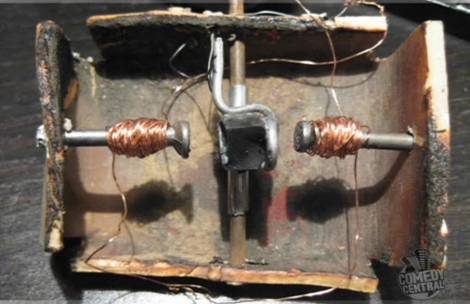Last night [Jon Stewart] interviewed [William Kamkwamba] on The Daily Show. [William] is the young man from Malawi who at the age of 14 built a windmill generator out of discarded items. Now at 22 years old, [William] is working on his SAT scores in hopes that he can attend college in the US. We get a bit more insight about him and his build as he promotes his new book.
[William] was 14 when he completed the three month long build of his generator. He had previously dropped out of school because “my country was experiencing some famine”. The only resource he had at his disposal was a library that is funded by the US government (sounds like that turned out to be a good investment!).
After seeing a photograph of a windmill he was driven to succeed by the mantra: “somewhere somebody did it, it didn’t fall from the sky”. He goes on to explain how he built a circuit breaker (pictured above) to prevent a short circuit from burning his house down. Two nails are wrapped in wire with a magnet in the middle. If there is a short circuit, one of the nails will repel the magnet while the other attracts it. The nail is connect to a switch and when it moves to one side the switch is opened, breaking the circuit. Upon hearing this, [Stewart] makes the obvious comparison between [Macgyver] and [Kamkwamba].
One of the most endearing points in the interview is a story [William] shares about his first experience with the Internet. He was invited to the TED conference in 2007 and someone asked him if he’d used the Internet. Of course he hadn’t and they then started talking about using Google. When the search engine was explained to him he suggested that “windmill” be entered as a query. When millions of hits were returned his revelation was “Where was this Google all this time?”.
This is an amazing story that we can’t get enough of here at Hack a Day. Make sure you don’t miss the interview which starts 12:25 into the episode.













